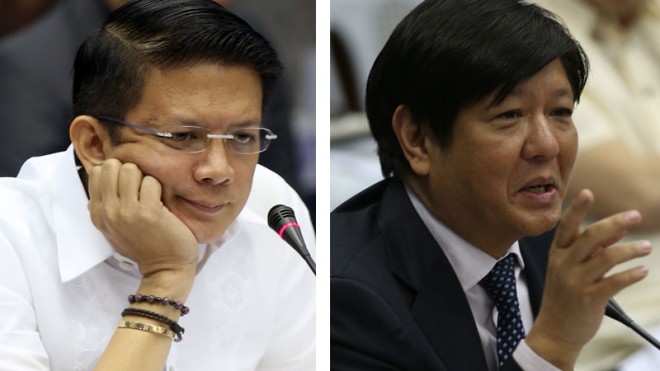Escudero, Marcos remain statistically tied in VP race
Senators Francis “Chiz” Escudero and Ferdinand “Bongbong” Marcos Jr. remain statistically tied in the race for Vice President, the latest Pulse Asia voter preference poll showed.
Nationwide, 29 percent of 1,800 respondents picked Escudero as the next Vice President, while 26 percent supported the son and namesake of the late dictator Ferdinand Marcos.
Behind them are Camarines Sur Rep. Leni Robredo (19 percent) and Senators Alan Peter Cayetano (12 percent), Antonio Trillanes IV (6 percent) and Gringo Honasan (4 percent).
Compared with the poll results in January, Escudero’s latest score is 4 points lower from 33 percent, while Marcos’ rating improved 3 points from 23 points.
The rating of Trillanes is up by 2 points from 4 percent last month. Robredo has gained a point, Cayetano has lost 2 points and Honasan is down by a point.
Article continues after this advertisementThe results of the poll released yesterday had a margin of error of plus-or-minus 2 percentage points. The poll was conducted from Feb. 15 to
Article continues after this advertisementFeb. 20.
Tight race
The vice presidential race is just as tight as the presidential race, said Pulse Asia president Ronald Holmes.
“Escudero and Marcos are also statistically tied,” Holmes said, noting that there is also no significant movement within classes and areas for the vice presidential candidates.
“However, it is worth noting that Senator Marcos has a sizable proportion of Class ABC preferring him,” he said.
Political science professor Edmund Tayao agreed, noting that Marcos has been going around the country and making himself known even before the official start of the campaign.
“Senator Marcos has already managed to catch up with Senator Escudero, who has preferred campaigning via the media,” he said.
Pulse Asia noted no significant changes in the vice presidential voter preference in different areas and socioeconomic classes between January and February.
Escudero’s ratings ranged from 22 percent (from 29 percent in January) in Mindanao to 35 percent (from 33 percent) in Metro Manila, and from 12 percent among ABC (from 24 percent) to 32 percent (from 34 percent) among Class D.
Preference for Marcos ranged from 17 percent (from 13 percent) in the Visayas to 34 percent (from 36 percent) in Metro Manila, while it ranged from 20 percent among Class D to 44 percent (from 28 percent) among Class ABC.
The scores of Robredo ranged from 28 percent (from 25 percent) in the Visayas to 10 percent (from 11 percent) in Metro Manila, and from 22 percent (from 21 percent) among Class ABC to 18 percent (from 16 percent) among Class E.
Ratings of Cayetano ranged from 22 percent in Mindanao to 7 percent (from 10 percent) in the rest of Luzon, and from 15 percent (from 16 percent) among Class E to 11 percent (from 17 percent) among Class ABC.
Those who supported Trillanes ranged from 9 percent (from 6 percent) in Mindanao to 3 percent (from 4 percent) in Metro Manila, and it ranged from 6 percent (from 4 percent) among Class D to 3 percent (from 4 percent) among Class ABC.
Honasan’s scores ranged from 6 percent (from 3 percent) in Mindanao to 4 percent in Metro Manila (from 5 percent), the rest of Luzon (from 5 percent) and the Visayas (from 6 percent). It ranged from 6 percent (from 7 percent) among Class E to 4 percent from Class ABC (from 2 percent) and D (5 percent).
RELATED VIDEOS
